Suomen historia
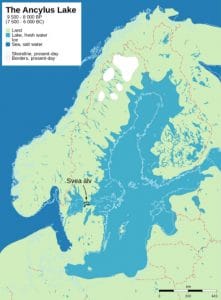
Ancylus Lake covered major part of Finland (7,500–6,000 BC)
Summary
The History of Finland begins around 9,000 BC during the end of the last glacial period. Stone Age cultures were Kunda, Comb Ceramic, Corded Ware, Kiukainen, and Pöljä cultures. The Finnish Bronze Age started in approximately 1,500 BC and the Iron Age started in 500 BC and lasted until 1,300 AD. Finnish Iron Age cultures can be separated into Finnish proper, Tavastian, and Karelian cultures. The earliest written sources mentioning Finland start to appear from the 12th century onwards when the Catholic Church started to gain a foothold in Southwest Finland.
Due to the Northern Crusades and Swedish colonisation of some Finnish coastal areas, most of the region became a part of the Kingdom of Sweden and the realm of the Catholic Church from the 13th century onwards. After the Finnish War in 1809, the vast majority of the Finnish-speaking areas of Sweden were ceded to the Russian Empire (excluding the areas of modern-day Northern Sweden where Meänkieli dialects of Finnish are spoken), making this area the autonomous Grand Duchy of Finland. The Lutheran religion dominated. Finnish nationalism emerged in the 19th century. It focused on Finnish cultural traditions, folklore, and mythology, including music and—especially—the highly distinctive language and lyrics associated with it. One product of this era was the Kalevala, one of the most significant works of Finnish literature. The catastrophic Finnish famine of 1866–1868 was followed by eased economic regulations and extensive emigration.
In 1917, Finland declared independence. A civil war between the Finnish Red Guards and the White Guard ensued a few months later, with the Whites gaining the upper hand during the springtime of 1918. After the internal affairs stabilized, the still mainly agrarian economy grew relatively quickly. Relations with the West, especially Sweden and Britain, were strong but tensions remained with the Soviet Union. During the Second World War, Finland fought twice against the Soviet Union, first defending its independence in the Winter War and then invading the Soviet Union in the Continuation War. In the peace settlement Finland ended up ceding a large part of Karelia and some other areas to the Soviet Union. However, Finland remained an independent democracy in Northern Europe.
In the latter half of its independent history, Finland has maintained a mixed economy. Since its post–World War II economic boom in the 1970s, Finland’s GDP per capita has been among the world’s highest. The expanded welfare state of Finland from 1970 and 1990 increased the public sector employees and spending and the tax burden imposed on the citizens. In 1992, Finland simultaneously faced economic overheating and depressed Western, Russian, and local markets. Finland joined the European Union in 1995, and replaced the Finnish markka with the euro in 2002. According to a 2016 poll, 61% of Finns preferred not to join NATO.
Paleolithic – Mesolithic – Neolithic
Paleolithic
If confirmed, the oldest archeological site in Finland would be the Wolf Cave in Kristinestad, in Ostrobothnia. The site would be the only pre-glacial (Neanderthal) site so far discovered in the Nordic Countries, and it is approximately 125,000 years old.
Mesolithic
The Antrea Net (8,300 BC) The oldest-known fishing net in the world
The last ice age in the area of the modern-day Finland ended c. 9000 BC. Starting about that time, people migrated to the area of Finland from the South and South-East. Their culture represented mixture of Kunda, Butovo, and Veretje cultures. At the same time, northern Finland was inhabited via the coast of Norway. The oldest confirmed evidence of the post-glacial human settlements in Finland are from the area of Ristola in Lahti and from Orimattila, from c. 8900 BC. Finland has been continuously inhabited at least since the end of the last ice age, up to the present. The earliest post-glacial inhabitants of the present-day area of Finland were probably mainly seasonal hunter-gatherers. Among finds is the net of Antrea, the oldest fishing net known ever to have been excavated (calibrated carbon dating: ca. 8300 BC).
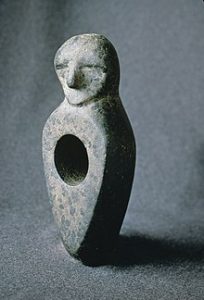
Stone Age stone axe engraved with human face found from Kiuruvesi.
Neolithic
By 5300 BC, pottery was present in Finland. The earliest samples belong to the Comb Ceramic Cultures, known for their distinctive decorating patterns. This marks the beginning of the neolithic period for Finland, although subsistence was still based on hunting and fishing. Extensive networks of exchange existed across Finland and northeastern Europe during the 5th millennium BC. For example, flint from Scandinavia and the Valdai Hills, amber from Scandinavia and the Baltic region, and slate from Scandinavia and Lake Onega found their way into Finnish archaeological sites, while asbestos and soap stone from Finland (e.g. the area of Saimaa) were found in other regions. Rock paintings—apparently related to shamanistic and totemistic belief systems—have been found, especially in Eastern Finland, e.g. Astuvansalmi.
Between 3500 and 2000 BC, monumental stone enclosures colloquially known as Giant’s Churches (Finnish: Jätinkirkko) were constructed in the Ostrobothnia region. The purpose of the enclosures is unknown.
In recent years, a dig in Kierikki site north of Oulu on River Ii (Ilijoki) has changed the image of Finnish neolithic Stone Age culture. The site had been inhabited year round and its inhabitants traded extensively. Kierikki culture is also seen as a subtype of Comb Ceramic culture. More of the site is excavated annually.
From 3200 BC onwards, either immigrants or a strong cultural influence from south of the Gulf of Finland settled in southwestern Finland. This culture was a part of the European Battle Axe cultures, which have often been associated with the movement of the Indo-European speakers. The Battle Axe, or Cord Ceramic, culture seems to have practiced agriculture and animal husbandry outside of Finland, but the earliest confirmed traces of agriculture in Finland date later, approximately to the 2nd millennium BC. Further inland, the societies retained their hunting-gathering lifestyles for the time being.
The Battle Axe and Comb Ceramic cultures eventually merged, giving rise to the Kiukainen culture that existed between 2300 BC, and 1500 BC, and was fundamentally a comb ceramic tradition with cord ceramic characteristics.
Bronze Age – Iron Age
Bronze Age
The Bronze Age began some time after 1500 BC. The coastal regions of Finland were a part of the Nordic Bronze Culture, whereas in the inland regions the influences came from the bronze-using cultures of northern and eastern Russia.
Iron Age
The Iron Age in Finland is considered to last from c. 500 BC until c. 1300 AD when known official and written records of Finland become more common due to the Swedish invasions as part of the Northern Crusades in the 13th century. As the Finnish Iron Age lasted almost two millennia, it is further divided into six sub-periods:
- Pre-Roman period: 500 BC – 1 BC
- Roman period: 1 AD – 400 AD
- Migration period: 400 AD – 575 AD
- Merovingian period: 575 AD – 800 AD
- Viking age period: 800 AD – 1025 AD
- Crusade period: 1033 AD – 1300 AD
Very few written records of Finland or its people remain in any language of the era. Primary written sources are thus mostly of foreign origin, most informative of which include Tacitus’ description of Fenni in his Germania, the sagas written down by Snorri Sturluson, as well as the 12th- and 13th-century ecclesiastical letters written for Finns. Numerous other sources from the Roman period onwards contain brief mentions of ancient Finnish kings and place names, as such defining Finland as a kingdom and noting the culture of its people.
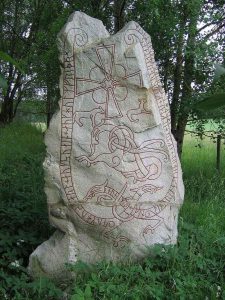
Runestone
Currently the oldest known Scandinavian documents mentioning a ”land of the Finns” are two runestones: Söderby, Sweden, with the inscription finlont, and Gotland with the inscription finlandi dating from the 11th century. However, as the long continuum of the Finnish Iron Age into the historical Medieval period of Europe suggests, the primary source of information of the era in Finland is based on archaeological findings and modern applications of natural scientific methods like those of DNA analysis or computer linguistics.
Production of iron during the Finnish Iron Age was adopted from the neighboring cultures in the east, west and south about the same time as the first imported iron artifacts appear. This happened almost simultaneously in various parts of the country.
Pre-Roman, Roman, Migration & Merovingian period
Pre-Roman period: 500 BC – 1 BC
The Pre-Roman period of the Finnish Iron Age is scarcest in findings, but the known ones suggest that cultural connections to other Baltic cultures were already established. The archeological findings of Pernaja and Savukoski provides proof of this argument. Many of the era’s dwelling sites are the same as those of the Neolithic. Most of the iron of the era was produced on site.
Roman period: 1 AD – 400 AD
The Roman period brought along an influx of imported iron (and other) artifacts like Roman wine glasses and dippers as well as various coins of the Empire. During this period the (proto) Finnish culture stabilized on the coastal regions and larger graveyards become commonplace. The prosperity of the Finns rose to the level that the vast majority of gold treasures found within Finland date back to this period.
Migration period: 400 AD – 575 AD
The Migration period saw the expansion of land cultivation inland, especially in Southern Bothnia, and the growing influence of Germanic cultures, both in artifacts like swords and other weapons and in burial customs. However most iron as well as its forging was of domestic origin, probably from bog iron.
Merovingian period: 575 AD – 800 AD
The Merovingian period in Finland gave rise to distinctive fine crafts culture of its own, visible in the original decorations of domestically produced weapons and jewelry. Finest luxury weapons were, however, imported from Western Europe. The very first Christian burials are from the latter part of this era as well. In the Leväluhta burial findings the average height of a man was originally thought to be just 158 cm and that of a woman 147 cm. but the recent research has corrected these numbers upwards and has confirmed that the people buried in Leväluhta were of average height for the era in Europe.
Recent findings suggest that Finnish trade connections already became more active during the 8th century bringing an influx of silver onto Finnish markets. The opening of the eastern route to Constantinople via Finland’s southern coastline archipelago brought Arabic and Byzantine artifacts into the excavation findings of the era.
The earliest findings of imported iron blades and local iron working appear in 500 BC. From about 50 AD, there are indications of a more intense long-distance exchange of goods in coastal Finland. Inhabitants exchanged their products, presumably mostly furs, for weapons and ornaments with the Balts and the Scandinavians as well as with the peoples along the traditional eastern trade routes. The existence of richly furnished burials, usually with weapons, suggests that there was a chiefly elite in the southern and western parts of the country. Hillforts spread over most of southern Finland at the end of the Iron and early Medieval Age. There is no commonly accepted evidence of early state formations in Finland, and the presumably Iron Age origins of urbanization are contested.
Middle Ages
Middle Ages
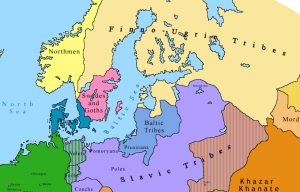
Northern Europe in 814
Contact between Sweden and what is now Finland was considerable even during pre-Christian times; the Vikings were known to the Finns due to their participation in both commerce and plundering. There is possible evidence of Viking settlement in the Finnish mainland. The Åland Islands probably had Swedish settlement during the Viking Period. However, some scholars claim that the archipelago was deserted during the 11th century. According to the archaeological finds, Christianity gained a foothold in Finland during the 11th century. According to the very few written documents that have survived, the church in Finland was still in its early development in the 12th century. Later medieval legends from late 13th century describe Swedish attempts to conquer and Christianize Finland sometime in the mid-1150s.
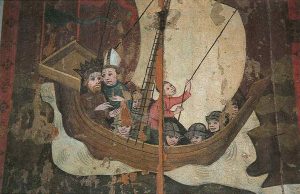
Eric IX of Sweden and Bishop Henry en route to Finland
In the early 13th century, Bishop Thomas became the first known bishop of Finland. There were several secular powers who aimed to bring the Finnish tribes under their rule. These were Sweden, Denmark, the Republic of Novgorod in northwestern Russia, and probably the German crusading orders as well. Finns had their own chiefs, but most probably no central authority. At the time there can be seen three cultural areas or tribes in Finland: Finns, Tavastians and Karelians. Russian chronicles indicate there were several conflicts between Novgorod and the Finnic tribes from the 11th or 12th century to the early 13th century.
It was the Swedish regent, Birger Jarl, who allegedly established Swedish rule in Finland through the Second Swedish Crusade, most often dated to 1249. The Eric Chronicle, the only source narrating the ”crusade”, describes that it was aimed at Tavastians. A papal letter from 1237 states that the Tavastians had reverted from Christianity to their old ethnic faith.
Novgorod gained control in Karelia in 1278, the region inhabited by speakers of Eastern Finnish dialects. Sweden however gained the control of Western Karelia with the Third Swedish Crusade in 1293. Western Karelians were from then on viewed as part of the western cultural sphere, while eastern Karelians turned culturally to Russia and Orthodoxy. While eastern Karelians remain linguistically and ethnically closely related to the Finns, they are generally considered a separate people.[30] Thus, the northern part of the border between Catholic and Orthodox Christendom came to lie at the eastern border of what would become Finland with the Treaty of Nöteborg with Novgorod in 1323.

Perniö costume reconstruction from 12th century grave
During the 13th century, Finland was integrated into medieval European civilization. The Dominican order arrived in Finland around 1249 and came to exercise great influence there. In the early 14th century, the first records of Finnish students at the Sorbonne appear. In the southwestern part of the country, an urban settlement evolved in Turku. Turku was one of the biggest towns in the Kingdom of Sweden, and its population included German merchants and craftsmen. Otherwise the degree of urbanization was very low in medieval Finland. Southern Finland and the long coastal zone of the Gulf of Bothnia had a sparse farming settlements, organized as parishes and castellanies. In the other parts of the country a small population of Sami hunters, fishermen, and small-scale farmers lived. These were exploited by the Finnish and Karelian tax collectors. During the 12th and 13th centuries, great numbers of Swedish settlers moved to the southern and northwestern coasts of Finland, to the Åland Islands, and to the archipelago between Turku and the Åland Islands. In these regions, the Swedish language is widely spoken even today. Swedish came to be the language of the upper class in many other parts of Finland as well.
The name ”Finland” originally signified only the southwestern province, which has been known as ”Finland Proper” since the 18th century. The first known mention of Finland is in runestone Gs 13 from 11th century. The original Swedish term for the realm’s eastern part was Österlands (”Eastern Lands”), a plural, meaning the area of Finland Proper, Tavastia, and Karelia. This was later replaced by the singular form Österland, which was in use between 1350–1470. In the 15th century Finland began to be used synonymously with Österland. The concept of a Finnish ”country” in the modern sense developed slowly from the 15th to 18th.

Turku Cathedral
During the 13th century, the bishopric of Turku was established. Turku Cathedral was the center of the cult of Saint Henry of Uppsala, and naturally the cultural center of the bishopric. The bishop had ecclesiastical authority over much of today’s Finland, and was usually the most powerful man there. Bishops were often Finns, whereas the commanders of castles were more often Scandinavian or German noblemen. In 1362, representatives from Finland were called to participate in the elections for the king of Sweden. As such, that year is often considered when Finland was incorporated into the Kingdom of Sweden. As in the Scandinavian part of the kingdom, the gentry or (lower) nobility consisted of magnates and yeomen who could afford armament for a man and a horse; these were concentrated in the southern part of Finland.
The strong fortress of Viborg (Finnish: Viipuri, Russian: Vyborg) guarded the eastern border of Finland. Sweden and Novgorod signed the Treaty of Nöteborg (Pähkinäsaari in Finnish) in 1323, but that did not last long. In 1348 the Swedish king Magnus Eriksson staged a failed crusade against Orthodox ”heretics”, managing only to alienate his supporters and ultimately lose his crown. The bones of contention between Sweden and Novgorod were the northern coastline of the Gulf of Bothnia and the wilderness regions of Savo in Eastern Finland. Novgorod considered these as hunting and fishing grounds of its Karelian subjects, and protested against the slow infiltration of Catholic settlers from the West. Occasional raids and clashes between Swedes and Novgorodians occurred during the late 14th and 15th centuries, but for most of the time an uneasy peace prevailed.
During the 1380s, a civil war in the Scandinavian part of Sweden brought unrest to Finland as well. The victor of this struggle was Queen Margaret I of Denmark, who brought the three Scandinavian kingdoms of Sweden, Denmark and, Norway under her rule (the ”Kalmar Union”) in 1389. The next 130 years or so were characterized by attempts of different Swedish factions to break out of the Union. Finland was sometimes involved in these struggles, but in general the 15th century seems to have been a relatively prosperous time[citation needed], characterized by population growth and economic development. Towards the end of the 15th century, however, the situation on the eastern border became more tense. The Principality of Moscow conquered Novgorod, preparing the way for a unified Russia, and from 1495–1497 a war was fought between Sweden and Russia. The fortress-town of Viborg withstood a Russian siege; according to a contemporary legend, it was saved by a miracle.
16th & 17th century
16th century
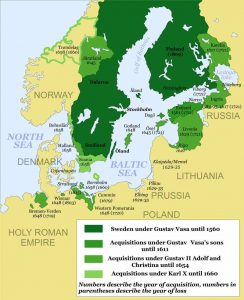
Swedish Empire (1560-1815)
The Swedish empire at its largest. Most of present-day Finland was part of Sweden proper, rike, shown in dark green.
In 1521 the Kalmar Union collapsed and Gustav Vasa became the King of Sweden. During his rule, the Swedish church was reformed. The state administration underwent extensive reforms and development too, giving it a much stronger grip on the life of local communities—and ability to collect higher taxes. Following the policies of the Reformation, in 1551 Mikael Agricola, bishop of Turku, published his translation of the New Testament into the Finnish language.
In 1550 Helsinki was founded by Gustav Vasa under the name of Helsingfors, but remained little more than a fishing village for more than two centuries.
King Gustav Vasa died in 1560 and his crown was passed to his three sons in separate turns. King Erik XIV started an era of expansion when the Swedish crown took the city of Tallinn in Estonia under its protection in 1561. This action contributed to the early stages of the Livonian War which was a warlike era which lasted for 160 years. In the first phase, Sweden fought for the lordship of Estonia and Latvia against Denmark, Poland and Russia. The common people of Finland suffered because of drafts, high taxes, and abuse by military personnel. This resulted in the Cudgel War of 1596–1597, a desperate peasant rebellion, which was suppressed brutally and bloodily. A peace treaty (the Treaty of Teusina) with Russia in 1595 moved the border of Finland further to the east and north, very roughly where the modern border lies.
An important part of the 16th-century history of Finland was growth of the area settled by the farming population. The crown encouraged farmers from the province of Savonia to settle the vast wilderness regions in Middle Finland. This often forced the original Sami population to leave. Some of the wilderness settled was traditional hunting and fishing territory of Karelian hunters. During the 1580s, this resulted in a bloody guerrilla warfare between the Finnish settlers and Karelians in some regions, especially in Ostrobothnia.
17th century
In 1611–1632 Sweden was ruled by King Gustavus Adolphus, whose military reforms transformed the Swedish army from a peasant militia into an efficient fighting machine, possibly the best in Europe. The conquest of Livonia was now completed, and some territories were taken from internally divided Russia in the Treaty of Stolbova. In 1630, the Swedish (and Finnish) armies marched into Central Europe, as Sweden had decided to take part in the great struggle between Protestant and Catholic forces in Germany, known as the Thirty Years’ War. The Finnish light cavalry was known as the Hakkapeliitat.

Grand Duchy of Finland 1662
After the Peace of Westphalia in 1648, the Swedish Empire was one of the most powerful countries in Europe. During the war, several important reforms had been made in Finland:
1637–1640 and 1648–1654 Count Per Brahe functioned as general governor of Finland. Many important reforms were made and many towns were founded. His period of administration is generally considered very beneficial to the development of Finland.
1640 Finland’s first university, the Academy of Åbo, was founded in Turku at the proposal of Count Per Brahe by Queen Christina of Sweden.
1642 The whole Bible was published in Finnish.
However, the high taxation, continuing wars and the cold climate (the Little Ice Age) made the Imperial era of Sweden rather gloomy times for Finnish peasants. In 1655–1660, the Northern Wars were fought, taking Finnish soldiers to the battle-fields of Livonia, Poland and Denmark. In 1676, the political system of Sweden was transformed into an absolute monarchy.
In Middle and Eastern Finland, great amounts of tar were produced for export. European nations needed this material for the maintenance of their fleets. According to some theories, the spirit of early capitalism in the tar-producing province of Ostrobothnia may have been the reason for the witch-hunt wave that happened in this region during the late 17th century. The people were developing more expectations and plans for the future, and when these were not realized, they were quick to blame witches—according to a belief system the Lutheran church had imported from Germany.
The Empire had a colony in the New World in the modern-day Delaware-Pennsylvania area between 1638–1655. At least half of the immigrants were of Finnish origin.
The 17th century was an era of very strict Lutheran orthodoxy. In 1608, the law of Moses was declared the law of the land, in addition to secular legislation. Every subject of the realm was required to confess the Lutheran faith and church attendance was mandatory. Ecclesiastical penalties were widely used. The rigorous requirements of orthodoxy were revealed in the dismissal of the Bishop of Turku, Johan Terserus, who wrote a catechism which was decreed heretical in 1664 by the theologians of the Academy of Åbo. On the other hand, the Lutheran requirement of the individual study of Bible prompted the first attempts at wide-scale education. The church required from each person a degree of literacy sufficient to read the basic texts of the Lutheran faith. Although the requirements could be fulfilled by learning the texts by heart, also the skill of reading became known among the population.
In 1696–1699, a famine caused by climate decimated Finland. A combination of an early frost, the freezing temperatures preventing grain from reaching Finnish ports, and a lackluster response from the Swedish government saw about one-third of the population die.[35] Soon afterwards, another war determining Finland’s fate began (the Great Northern War of 1700–21).
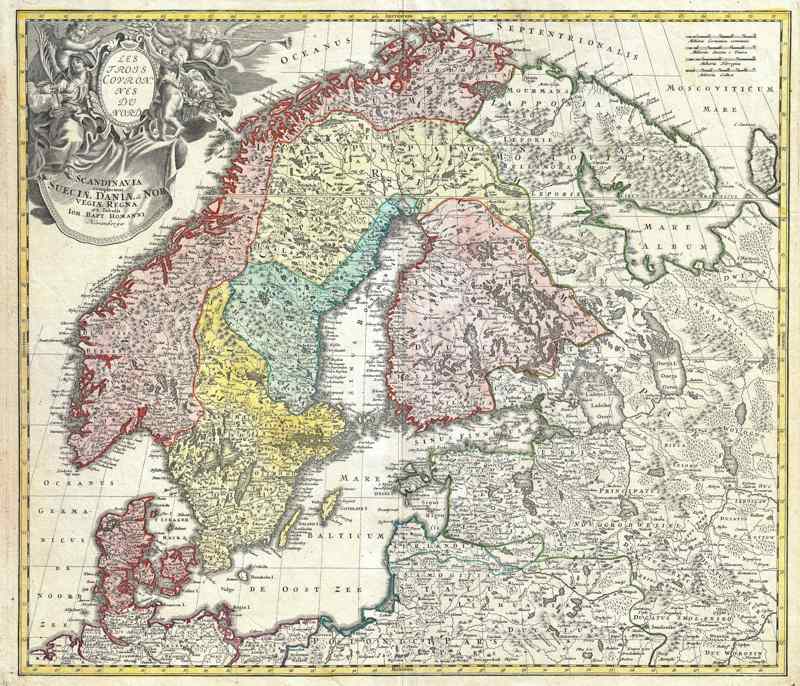
A 1730 map depicting Finland and Scandinavia region
18th century
18th century
The Great Northern War (1700–1721) was devastating, as Sweden and Russia fought for control of the Baltic. Harsh conditions—worsening poverty and repeated crop failures—among peasants undermined support for the war, leading to Sweden’s defeat. Finland was a battleground as both armies ravaged the countryside, leading to famine, epidemics, social disruption and the loss of nearly half the population. By 1721 only 250,000 remained. Landowners had to pay higher wages to keep their peasants. Russia was the winner, annexing the south-eastern part, including the town of Viborg, after the Treaty of Nystad. The border with Russia came to lie roughly where it returned to after World War II. Sweden’s status as a European great power was forfeited, and Russia was now the leading power in the North. The absolute monarchy ended in Sweden. During this Age of Liberty, the Parliament ruled the country, and the two parties of the Hats and Caps struggled for control leaving the lesser Court party, i.e. parliamentarians with close connections to the royal court, with little to no influence. The Caps wanted to have a peaceful relationship with Russia and were supported by many Finns, while other Finns longed for revenge and supported the Hats.
Finland by this time was depopulated, with a population in 1749 of 427,000. However, with peace the population grew rapidly, and doubled before 1800. 90% of the population were typically classified as ”peasants”, most being free taxed yeomen. Society was divided into four Estates: peasants (free taxed yeomen), the clergy, nobility and burghers. A minority, mostly cottagers, were estateless, and had no political representation. Forty-five percent of the male population were enfranchised with full political representation in the legislature—although clerics, nobles and townsfolk had their own chambers in the parliament, boosting their political influence and excluding the peasantry on matters of foreign policy.
The mid-18th century was a relatively good time, partly because life was now more peaceful. However, during the Lesser Wrath (1741–1742), Finland was again occupied by the Russians after the government, during a period of Hat party dominance, had made a botched attempt to reconquer the lost provinces. Instead the result of the Treaty of Åbo was that the Russian border was moved further to the west. During this time, Russian propaganda hinted at the possibility of creating a separate Finnish kingdom.
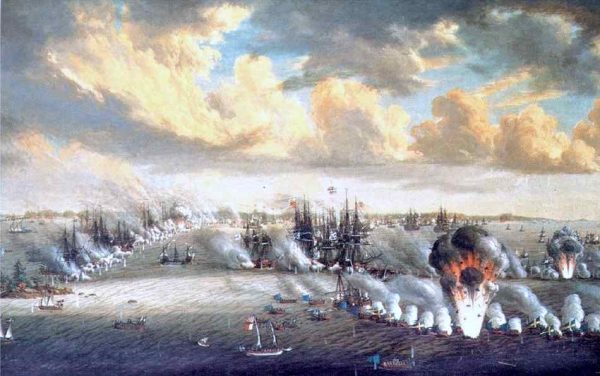
The Battle of Svensksund was a naval battle fought in the Gulf of Finland outside the present day city of Kotka on 9 and 10 July 1790
Both the ascending Russian Empire and pre-revolutionary France aspired to have Sweden as a client state. Parliamentarians and others with influence were susceptible to taking bribes which they did their best to increase. The integrity and the credibility of the political system waned, and in 1771 the young and charismatic king Gustav III staged a coup d’état, abolished parliamentarism and reinstated royal power in Sweden—more or less with the support of the parliament. In 1788, he started a new war against Russia. Despite a couple of victorious battles, the war was fruitless, managing only to bring disturbance to the economic life of Finland. The popularity of King Gustav III waned considerably. During the war, a group of officers made the famous Anjala declaration demanding peace negotiations and calling of Riksdag (Parliament). An interesting sideline to this process was the conspiracy of some Finnish officers, who attempted to create an independent Finnish state with Russian support. After an initial shock, Gustav III crushed this opposition. In 1789, the new constitution of Sweden strengthened the royal power further, as well as improving the status of the peasantry. However, the continuing war had to be finished without conquests—and many Swedes now considered the king as a tyrant.
With the interruption of the Gustav III’s war (1788–1790), the last decades of the 18th century had been an era of development in Finland. New things were changing even everyday life, such as starting of potato farming after the 1750s. New scientific and technical inventions were seen. The first hot air balloon in Finland (and in the whole Swedish kingdom) was made in Oulu (Uleåborg) in 1784, only a year after it was invented in France. Trade increased and the peasantry was growing more affluent and self-conscious. The Age of Enlightenment’s climate of broadened debate in the society on issues of politics, religion and morals would in due time highlight the problem that the overwhelming majority of Finns spoke only Finnish, but the cascade of newspapers, belles-lettres and political leaflets was almost exclusively in Swedish—when not in French.
The two Russian occupations had been harsh and were not easily forgotten. These occupations were a seed of a feeling of separateness and otherness, that in a narrow circle of scholars and intellectuals at the university in Turku was forming a sense of a separate Finnish identity representing the eastern part of the realm. The shining influence of the Russian imperial capital Saint Petersburg was also much stronger in southern Finland than in other parts of Sweden, and contacts across the new border dispersed the worst fears for the fate of the educated and trading classes under a Russian régime. At the turn of the 19th century, the Swedish-speaking educated classes of officers, clerics and civil servants were mentally well prepared for a shift of allegiance to the strong Russian Empire.
King Gustav III was assassinated in 1792, and his son Gustav IV Adolf assumed the crown after a period of regency. The new king was not a particularly talented ruler; at least not talented enough to steer his kingdom through the dangerous era of the French Revolution and Napoleonic wars.
Meanwhile, the Finnish areas belonging to Russia after the peace treaties in 1721 and 1743 (not including Ingria), called ”Old Finland” were initially governed with the old Swedish laws (a not uncommon practice in the expanding Russian Empire in the 18th century). However, gradually the rulers of Russia granted large estates of land to their non-Finnish favorites, ignoring the traditional landownership and peasant freedom laws of Old Finland. There were even cases where the noblemen punished peasants corporally, for example by flogging. The overall situation caused decline in the economy and morale in Old Finland, worsened since 1797 when the area was forced to send men to the Imperial Army. The construction of military installations in the area brought thousands of non-Finnish people to the region. In 1812, after the Russian conquest of Finland, ”Old Finland” was rejoined to the rest of the country but the landownership question remained a serious problem until the 1870s.
Russian Grand Duchy, Independence and Civil War & Inter-war era
Russian Grand Duchy

A view of Helsinki from the late 19th century, by Oscar Kleineh (1846–1919).

Grand Duchy of Finland-75 kopeks (1824)
During the Finnish War between Sweden and Russia, Finland was again conquered by the armies of Tsar Alexander I. The four Estates of occupied Finland were assembled at the Diet of Porvoo on March 29, 1809 to pledge allegiance to Alexander I of Russia. Following the Swedish defeat in the war and the signing of the Treaty of Fredrikshamn on September 17, 1809, Finland remained a Grand Duchy in the Russian Empire until the end of 1917, with the czar as Grand Duke. Russia assigned Karelia (”Old Finland”) to the Grand Duchy in 1812. During the years of Russian rule the degree of autonomy varied. Periods of censorship and political prosecution occurred, particularly in the two last decades of Russian control, but the Finnish peasantry remained free (unlike the Russian serfs) as the old Swedish law remained effective (including the relevant parts from Gustav III’s Constitution of 1772). The old four-chamber Diet was re-activated in the 1860s agreeing to supplementary new legislation concerning internal affairs. In addition, Finns remained free of obligations connected to the empire, such as the duty to serve in tsarist armies, and they enjoyed certain rights that citizens from other parts of the empire did not have.
Independence and Civil War
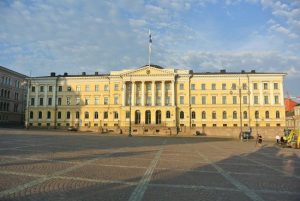
Senate Helsinki
In the aftermath of the February Revolution in Russia, Finland received a new Senate, and a coalition Cabinet with the same power distribution as the Finnish Parliament. Based on the general election in 1916, the Social Democrats had a small majority, and the Social Democrat Oskari Tokoi became prime minister. The new Senate was willing to cooperate with the Provisional government of Russia, but no agreement was reached. Finland considered the personal union with Russia to be over after the dethroning of the Tsar—although the Finns had de facto recognized the Provisional government as the Tsar’s successor by accepting its authority to appoint a new Governor General and Senate. They expected the Tsar’s authority to be transferred to Finland’s Parliament, which the Provisional government refused, suggesting instead that the question should be settled by the Russian Constituent Assembly.
For the Finnish Social Democrats it seemed as though the bourgeoisie was an obstacle on Finland’s road to independence as well as on the proletariat’s road to power. The non-Socialists in Tokoi’s Senate were, however, more confident. They, and most of the non-Socialists in the Parliament, rejected the Social Democrats’ proposal on parliamentarism (the so-called ”Power Act”) as being too far-reaching and provocative. The act restricted Russia’s influence on domestic Finnish matters, but didn’t touch the Russian government’s power on matters of defence and foreign affairs. For the Russian Provisional government this was, however, far too radical, exceeding the Parliament’s authority, and so the Provisional government dissolved the Parliament.
The minority of the Parliament, and of the Senate, were content. New elections promised a chance for them to gain a majority, which they were convinced would improve the chances to reach an understanding with Russia. The non-Socialists were also inclined to cooperate with the Russian Provisional Government because they feared the Social Democrats’ power would grow, resulting in radical reforms, such as equal suffrage in municipal elections, or a land reform. The majority had the completely opposite opinion. They didn’t accept the Provisional government’s right to dissolve the Parliament.
The Social Democrats held on to the Power Act and opposed the promulgation of the decree of dissolution of the Parliament, whereas the non-Socialists voted for promulgating it. The disagreement over the Power Act led to the Social Democrats leaving the Senate. When the Parliament met again after the summer recess in August 1917, only the groups supporting the Power Act were present. Russian troops took possession of the chamber, the Parliament was dissolved, and new elections were held. The result was a (small) non-Socialist majority and a purely non-Socialist Senate. The suppression of the Power Act, and the cooperation between Finnish non-Socialists and Russia provoked great bitterness among the Socialists, and had resulted in dozens of politically motivated attacks and murders.
Independence
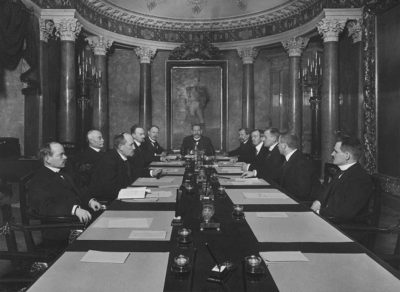
The Senate declared Finland independent on 4th December 1917 and it was confirmed by parliament 6th December 1917 which became the Independence Day of Finland.
The October Revolution of 1917 turned Finnish politics upside down. Now, the new non-Socialist majority of the Parliament desired total independence, and the Socialists came gradually to view Soviet Russia as an example to follow. On November 15, 1917, the Bolsheviks declared a general right of self-determination ”for the Peoples of Russia”, including the right of complete secession. On the same day the Finnish Parliament issued a declaration by which it temporarily took power in Finland.
Worried by developments in Russia and Finland, the non-Socialist Senate proposed that Parliament declare Finland’s independence, which was voted by the Parliament on December 6, 1917. On December 18 the Soviet government issued a Decree, recognizing Finland’s independence, and on December 22 it was approved by the highest Soviet executive body (VTsIK). Germany and the Scandinavian countries followed without delay.
Civil war
Finland after 1917 was bitterly divided along social lines. The Whites consisted of the Swedish-speaking middle and upper classes and the farmers and peasantry who dominated the northern two-thirds of the land. They had a conservative outlook and rejected socialism. The Socialist-Communist Reds comprised the Finnish-speaking urban workers and the landless rural cottagers. They had a radical outlook and rejected capitalism.
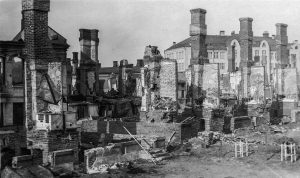
Tampere’s civilian buildings destroyed in the Civil War during the Battle of Tampere
From January to May 1918, Finland experienced the brief but bitter Finnish Civil War. On one side there were the ”white” civil guards, who fought for the anti-Socialists. On the other side were the Red Guards, which consisted of workers and tenant farmers. The latter proclaimed a Finnish Socialist Workers’ Republic. World War I was still underway and the defeat of the Red Guards was achieved with support from Imperial Germany, while Sweden remained neutral and Russia withdrew its forces. The Reds lost the war and the White peasantry rose to political leadership in the 1920s–1930s. About 37,000 men died, most of them in prisoner camps ravaged by influenza and other diseases.
Finland in the inter-war era
After the civil war, the parliament controlled by the Whites voted to establish a constitutional monarchy to be called the Kingdom of Finland, with a German prince as king. However, Germany’s defeat in November 1918 made the plan impossible and Finland instead became a republic, with Kaarlo Juho Ståhlberg elected as its first President in 1919. Despite the bitter civil war, and repeated threats from fascist movements, Finland became and remained a capitalist democracy under the rule of law. By contrast, nearby Estonia, in similar circumstances but without a civil war, started as a democracy and was turned into a dictatorship in 1934.
Finland in the Second World War
Finland in the Second World War
During the Second World War, Finland fought two wars against the Soviet Union: the Winter War of 1939–1940, resulting in the loss of Finnish Karelia, and the Continuation War of 1941–1944 (with considerable support from Nazi Germany resulting in a swift invasion of neighboring areas of the Soviet Union), eventually leading to the loss of Finland’s only ice-free winter harbour Petsamo. The Continuation War was, in accordance with the armistice conditions, immediately followed by the Lapland War of 1944–1945, when Finland fought the Germans to force them to withdraw from northern Finland back into Norway (then under German occupation). Finland was not occupied; its army of over 600,000 soldiers, saw only 3,500 prisoners-of-war. About 96,000 Finns lost their lives, or 2.5% of a population of 3.8 million; civilian casualties were under 2,500.
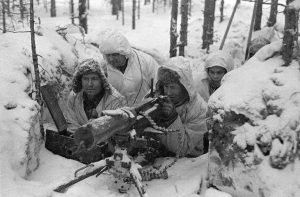
A Finnish machine gun crew during the Winter War 1939
In August 1939 Nazi-Germany and the Soviet Union signed the Molotov–Ribbentrop Pact, where Finland and the Baltic states were given to the Soviet ”sphere of influence”. After the Invasion of Poland, the Soviet Union sent ultimatums to the Baltic countries, where it demanded military bases on their soil. The Baltic states accepted Soviet demands, and lost their independence in the summer of 1940. In October 1939, the Soviet Union sent the same kind of request to Finland, but the Finns refused to give any land areas or military bases for the usage of the Red Army. This caused the Soviet Union to start a military invasion against Finland on 30 November 1939. Soviet leaders predicted that Finland would be conquered in a couple of weeks. However, even though the Red Army had huge superiority in men, tanks, guns and airplanes, the Finns were able to defend their country for about 3.5 months and still avoid invasion successfully. The Winter War ended on 13 March 1940 with the Moscow peace treaty, in which Finland lost the Karelian Isthmus to the Soviet Union. The Winter War was a big loss of prestige for the Soviet Union, and it was expelled from the League of Nations because of the illegal attack. Finland received much international goodwill and material help from many countries during the war.
After the Winter War the Finnish army was exhausted, and needed recovery and support as soon as possible. The British declined to help but in autumn 1940 Nazi Germany offered weapon deals to Finland, if the Finnish government would allow German troops to travel through Finland to occupied Norway. Finland accepted, weapon deals were made and military co-operation began in December 1940.
Finland’s support from, and coordination with, Nazi Germany starting during the winter of 1940–41 and made other countries considerably less sympathetic to the Finnish cause; particularly since the Continuation War led to a Finnish invasion of the Soviet Union designed not only to recover lost territory, but additionally to answer the irredentist sentiment of a Greater Finland by incorporating East Karelia, whose inhabitants were culturally related to the Finnish people, although Eastern Orthodox by religion. This invasion had caused Britain to declare war on Finland on 6 December 1941.
Finland managed to defend its democracy, contrary to most other countries within the Soviet sphere of influence, and suffered comparably limited losses in terms of civilian lives and property. It was, however, punished harsher than other German co-belligerents and allies, having to pay large reparations and resettle an eighth of its population after having lost an eighth of the territory including one of its industrial heartlands and the second-largest city of Viipuri.[70] After the war, the Soviet government settled these gained territories with people from many different regions of the USSR, for instance from Ukraine.
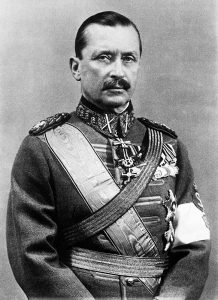
Field Marshal C.G.E. Mannerheim 1940
The Finnish government did not participate in the systematic killing of Jews, although the country remained a ”co-belligerent”, a de facto ally of Germany until 1944. In total, eight German Jewish refugees were handed over to the German authorities. In the Tehran Conference of 1942, the leaders of the Allies agreed that Finland was fighting a separate war against the Soviet Union, and that in no way was it hostile to the Western allies. The Soviet Union was the only Allied country against which Finland had conducted military operations. Unlike any of the Axis nations, Finland was a parliamentary democracy throughout the 1939–1945 period. The commander of Finnish armed forces during the Winter War and the Continuation War, Carl Gustaf Emil Mannerheim, became the President of Finland after the war. Finland made a separate peace contract with the Soviet Union on 19 September 1944, and was the only bordering country of USSR in Europe (alongside Norway, which has only gained its own border with the Soviet Union after the war) that kept its independence after the war.
During and in between the wars, approximately 80,000 Finnish war-children were evacuated abroad: 5% went to Norway, 10% to Denmark, and the rest to Sweden. Most of the children were sent back by 1948, but 15–20% remained abroad.
The Moscow Armistice was signed between Finland on one side and the Soviet Union and Britain on the other side on September 19, 1944, ending the Continuation War. The armistice compelled Finland to drive German troops from its territory, leading to the Lapland War 1944–1945.
In 1947, Finland reluctantly declined Marshall aid in order to preserve good relations with the Soviets, ensuring Finnish autonomy. Nevertheless, the United States shipped secret development aid and financial aid to the non-communist SDP (Social Democratic Party). Establishing trade with the Western powers, such as Britain, and the reparations to the Soviet Union caused Finland to transform itself from a primarily agrarian economy to an industrialised one. After the reparations had been paid off, Finland continued to trade with the Soviet Union in the framework of bilateral trade.
Finland’s role in the Second World War was in many ways strange. Firstly the Soviet Union tried to invade Finland in 1939–1940. However, even with massive superiority in military strength, the Soviet Union was unable to conquer Finland. In late 1940, German-Finnish co-operation began; it took a form that was unique when compared to relations with the Axis. Finland signed the Anti-Comintern Pact, which made Finland an ally with Germany in the war against the Soviet Union. But, unlike all other Axis states, Finland never signed the Tripartite Pact and so Finland never was de jure an Axis nation.
Memorials
Although Finland lost territory in both of its wars with the Soviets, the memory of these wars was sharply etched in the national consciousness. Despite its military defeats, Finland celebrates these wars as a victory for the Finnish national spirit, which survived against long odds and allowed Finland to maintain its independence. Many groups of Finns are commemorated [how, specifically?] today, including not just fallen soldiers and veterans, but also orphans, evacuees from Karelia, the children who were evacuated to Sweden, women who worked during the war at home or in factories, and the veterans of the women’s defense unit Lotta Svärd.
Some of these groups could not be properly commemorated until long after the war ended in order to preserve good relations with the Soviet Union. However, after a long political campaign backed by survivors of what Finns call the Partisan War, the Finnish Parliament passed legislation establishing compensation for the war’s victims.
History 1945 to present
History 1945 to present
Finland retained a democratic constitution and free economy during the Cold War era. Treaties signed in 1947 and 1948 with the Soviet Union included obligations and restraints on Finland, as well as territorial concessions. The Paris Peace Treaty (1947) limited the size and the nature of Finland’s armed forces. Weapons were to be solely defensive. A deepening of postwar tensions led a year later to the Treaty of Friendship, Cooperation, and Mutual Assistance (1948) with the Soviet Union. The latter, in particular, was the foundation of Finno-Soviet relations in the postwar era. Under the terms of the treaty, Finland was bound to confer with the Soviets and perhaps to accept their aid if an attack from Germany, or countries allied with Germany, seems likely. The treaty prescribed consultations between the two countries, but it had no mechanism for automatic Soviet intervention in a time of crisis. Both treaties have been abrogated by Finland since the 1991 dissolution of the Soviet Union, while leaving the borders untouched. Even though being a neighbor to the Soviet Union sometimes resulted in overcautious concern in foreign policy (”Finlandization”), Finland developed closer co-operation with the other Nordic countries and declared itself neutral in superpower politics.
The Finnish post-war president, Juho Kusti Paasikivi, a leading conservative politician, saw that an essential element of Finnish foreign policy must be a credible guarantee to the Soviet Union that it need not fear attack from, or through, Finnish territory. Because a policy of neutrality was a political component of this guarantee, Finland would ally itself with no one. Another aspect of the guarantee was that Finnish defenses had to be sufficiently strong to defend the nation’s territory. This policy remained the core of Finland’s foreign relations for the rest of the Cold War era.
In 1952, Finland and the countries of the Nordic Council entered into a passport union, allowing their citizens to cross borders without passports and soon also to apply for jobs and claim social security benefits in the other countries. Many from Finland used this opportunity to secure better-paying jobs in Sweden in the 1950s and 1960s, dominating Sweden’s first wave of post-war labour immigrants. Although Finnish wages and standard of living could not compete with wealthy Sweden until the 1970s, the Finnish economy rose remarkably from the ashes of World War II, resulting in the buildup of another Nordic-style welfare state.
Despite the passport union with Sweden, Norway, Denmark, and Iceland, Finland could not join the Nordic Council until 1955 because of Soviet fears that Finland might become too close to the West. At that time the Soviet Union saw the Nordic Council as part of NATO of which Denmark, Norway and Iceland were members. That same year Finland joined the United Nations, though it had already been associated with a number of UN specialized organisations. The first Finnish ambassador to the UN was G.A. Gripenberg (1956–1959), followed by Ralph Enckell (1959–1965), Max Jakobson (1965–1972), Aarno Karhilo (1972–1977), Ilkka Pastinen (1977–1983), Keijo Korhonen (1983–1988), Klaus Törnudd (1988–1991), Wilhelm Breitenstein (1991–1998) and Marjatta Rasi (1998–2005). In 1972 Max Jakobson was a candidate for Secretary-General of the UN. In another remarkable event of 1955, the Soviet Union decided to return the Porkkala peninsula to Finland, which had been rented to the Soviet Union in 1948 for 50 years as a military base, a situation which somewhat endangered Finnish sovereignty and neutrality.
Officially claiming to be neutral, Finland lay in the grey zone between the Western countries and the Soviet Union. The ”YYA Treaty” (Finno-Soviet Pact of Friendship, Cooperation, and Mutual Assistance) gave the Soviet Union some leverage in Finnish domestic politics. However, Finland maintained capitalism unlike most other countries bordering the Soviet Union. Property rights were strong. While nationalization committees were set up in France and UK, Finland avoided nationalizations. After failed experiments with protectionism in the 1950s, Finland eased restrictions and committed to a series of international free trade agreements: first an associate membership in the European Free Trade Association in 1961, a full membership in 1986 and also an agreement with the European Community in 1973. Local education markets expanded and an increasing number of Finns also went abroad to study in the United States or Western Europe, bringing back advanced skills. There was a quite common, but pragmatic-minded, credit and investment cooperation by state and corporations, though it was considered with suspicion. Support for capitalism was widespread. Savings rate hovered among the world’s highest, at around 8% until the 1980s. In the beginning of the 1970s, Finland’s GDP per capita reached the level of Japan and the UK. Finland’s economic development shared many aspects with export-led Asian countries.
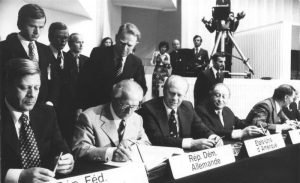
Signing the Helsinki Accords are the West German Chancellor Helmut Schmidt, East Germany’s leader Erich Honecker, US president Gerald Ford and the Austrian chancellor Bruno Kreisky
Building on its status as western democratic country with friendly ties with the Soviet Union, Finland pushed to reduce the political and military tensions of cold war. Since the 1960s, Finland urged the formation of a Nordic Nuclear Weapons Free Zone (Nordic NWFZ), and in 1972-1973 was the host of the Conference on Security and Cooperation in Europe (CSCE), which culminated in the signing of the Helsinki Accords in 1975 and lead to the creation of the OSCE.

Urho Kekkonen
In March 1992 Finland applied for EC membership. Earlier, on Jan. 1992, Finland signed a treaty of friendship with Russia. This treaty was a revised version of the 1948 treaty between Finland and the Soviet Union.
After a very deep recession, into which the country had entered after 1990, the economic recovery continued in 1994. The rapprochement with the West continued to be a factor in Finnish politics, leading to EU membership in January 1995. In October 1996, the government decided to transfer the Finnish mark to the European Monetary System (EMS).

Tarja Halonen

Sauli Niinistö
In February 2000, Finnish Foreign Minister Tarja Halonen won the Finnish presidential election. She thus became the first female head of state. In 2006, President Tarja Halonen is still very popular with the population and is re-elected for a second term. In April 2011, the center-right national coalition party becomes the largest in the parliamentary elections. In June, Jyrki Katainen will form a new government, including the far right new Finns. In February 2012, Sauli Niinistö becomes the first conservative president since 1956.

Sanna Marin
In October 2016, Finland signed an agreement with the US on better military cooperation in light of growing unrest over Russia’s actions towards the Baltic states. In December 2017, Finland will celebrated 100 years of independence. Niinisto won a second term as president in the 2018 elections. Social Democrat Sanna Marin took over as prime minister of a center-left coalition in 2019, after her predecessor Antti Rinne resigned over his handling of a post strike. Rinne, the leader of the Social Democratic Party (SDP), had come to power in June 2019 after defeating the center-right government. Marin was elected Prime Minister on December 8, 2019. At 35, she is the fourth youngest serving state leader in the world, the youngest female state leader and the youngest ever Prime Minister of Finland.
On 30-6-2022, NATO leaders took a historic decision to invite Finland and Sweden to become members of the alliance.
Jens Stoltenberg, the secretary general of NATO, said in a press conference that the agreement concluded between Turkey, Finland and Sweden paved the way for the decision to invite both Nordic countries to NATO.
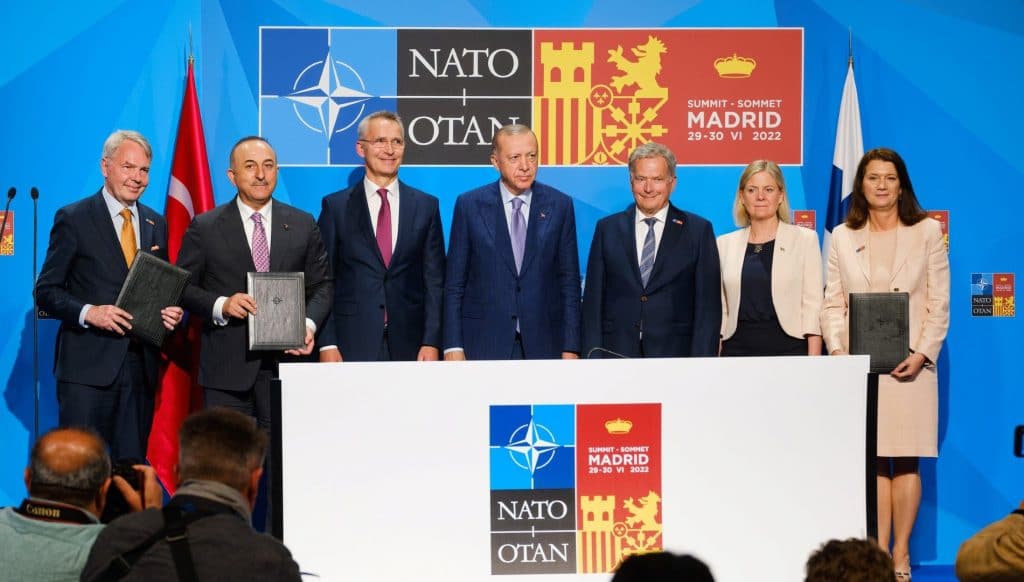
From left during the signing of the agreement between Turkey, Finland and Sweden in Madrid, Spain, on June 28, 2022: Pekka Haavisto, the minister of foreign affairs of Finland, Mevlüt Çavuşoğlu, the minister of foreign affairs of Turkey, Jens Stoltenberg, the secretary general of NATO, President Recep Tayyip Erdoğan of Türkey, President Sauli Niinistö of Finland and Prime Minister Magdalena Andersson of Sweden and Ann Linde, the minister of foreign affairs of Sweden.
Sources: WiKiPedia, infofinland.fi, britannica.com, discoveringfinland.com, landenweb.nl, finland.fi
